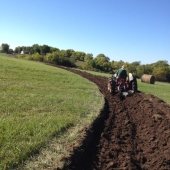Matthew Rogers wrote:Hello everyone, I recently dug two Swales on our 4% slope as we are planting three rows of fruit trees in a couple days. They are about five feet wide and 16-20 inches deep.The first swale is about 96 feet and the second is about 72'. We raked them all out and the upper swale is very close to level the first half of the ditch but then the swale drops about 3 inches in 25 feet and then another 3-4 inches the last 15-20 feet. I am wondering if this six inches over that distance will become a problem or if I am being to nit picky. Will this all be fine once I mulch over the bare soil? If so would straw and wood chips be appropriate fill for the Swales. I would also love to hear anyone's favorite plants to stabilize the berm between the fruit trees and their guilds. Thanks so much to all who read this.
I think it not being perfect is just fine, as long as you vegetate the exposed soil with a
perennial ground cover suitable to your climate. You will still have a water harvesting feature that will last a very long time. I would just suggest to strive for a more level swale on the next one. Everyone above made good points, depending on the situation you may want to have that 6" fall in 100' (for instance above an area you want to keep slightly drier.
I didn't however see anyone mention the fact that you need to diversify. You mentioned planting fruit trees and not much else, I think that might be a mistake that will cost you more labor in the end. You might consider inter-planting some support species for those trees before they get very big. It will do wonders towards the overall vitality of the
land and health/fertility of the soil. Plus its a darn site cheaper that buying all those soil amendments.
Now onto my recommended support plants, most are nitrogen fixers and many are bio-remediators. These are plants that can be planted between your future productive trees in order to have ecology on your side. Keep in mind, you can always cut them down and sheet mulch over them, thus speeding up succession all the same.
(the following are long-term overstory trees)
------------------------------------------------------------------------------------------------------------
Willow(weeping/various) Salix alba D. Tree 4-8
“ “(black) Salix Nigra “ 3-9
*( Use caution with willows, they are greedy and grow quite fast. Although best suited for wind breaks and site remediation, there are better choices for small sites. However i would recommend one or two, as there is an easily extracted rooting agent.)*
https://deepgreenpermaculture.com/diy-instructions/home-made-plant-rooting-hormone-willow-water/
Oak (black) Quercus velutina “ 3-9
Locust(Black) Robinia pseudoacacia “ 3-8
“ “(
Honey) Gleditsia triacanthos “ 4-7
*(Many of the Locust trees do have rather large thorns, which may be useful as a security hedge, but not ideal for chop and drop. Although i believe there's a pretty common thorn less variety)*
Alder(speckled) Alnus rugosa “ 2-7
Alder(common) Alnus glutinosa " 3-7
*( I highly reccomend the faster growing 'Alnus' genus for chop and drop support trees. They coppice well and have many other functions)*
KY
Coffee Tree Gymnocladus dioicus “ 3-8
Dogwood(Pagoda) Cornus alternifolia “ 3-7
*(The following should all be experiential, plant a bit and observe to see what works well where.)*
------------------------------------------------------------------------------------------------------------
Mimosa Albizia julibrissin “ 6-9
Golden-Chain Tree Laburnum anagyroides “ 5-7
False Indigo Amorpha fruticosa D. Shrub 3-9
Olive(autumn) Elaeagnus umbellata “ 3-9
“ “(Russian) Elaeagnus angustifolia “ 2-7
Pea shrub(Siberian) Caragana arborescens “ 2-7
“ “(Russian) Caragana frutex “ 2-7
“ “(Pygmy) Caragana pygmaea “ 3-7
Seaberry Hippophae rhamnoides D.Shrub 3-7
Bladder Senna Colutea arborescens “ 5-9
Bush clover Lespedeza thunbergii D. shrub 4-8
NJ Tea Ceanothus americanus “ 3-8
Bush clover(round) Lespedeza capitata P. Herb 3-8
Buffalo berry Shepherdia canadensis “ 2-6
Lead Plant Amorpha canescens “ 3-8
Milk vetch(g. plum) Astragalus crassicarpus “ 3-10
“ “(Painted) Astragalus ceramicus “ 3-9
Wild Indigo(Cream) Baptisia bracteata “ 2-8
“ “(White) Baptisia alba “ 3-9
Licorice(Cultivated) Glycyrrhiza glabra “ 6-9
“ “(Wild) Glycyrrhiza lepidota “ 3-8
Sweet Vetch Hedysarum boreale “ 3-9
“ “(White) Lupinus albus “ 4-9
“ “(Wild) Lupinus perennis “ 3-8
Prairie Turnip Psoralea esculenta “ 3-7
Clover(White) Trifolium repens “ 3-10
Pea(perennial) Lathyrus latifolius “ 3-9
Alfalfa Medicago sativa Annual 2-9
Black Medic Medicago lupulina “ 2-9
“ “(Crimson) Trifolium incarnatum “ 2-9
Groundnut Apios americana Vine 2-9
“ (Traveler’s Delight) Apios priceana “ 5-7
“ (Tuberous) Lathyrus tuberosus “ 3-8
There a ton more info about these plants and others at www.pfaf.org
Good luck and nice looking swale!

 1
1



































